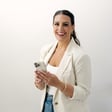The Role of Email Lists in Marketing
00:00:05
Speaker
I think mailing lists are so effective because they allow you to show up in people's inboxes. And again, that's the power of an email list right there, is that almost everybody has an email. Email's still how the world runs. Welcome to the Brands at Book Show, where we help creative, service-based businesses build their brands and find more clients. I'm your host, Davy Jones.
00:00:33
Speaker
I've said it before, but our email list is our most valued marketing channel. Today, Vanessa and I explore why that's the case and how you can implement all things email marketing in your business. After recording this episode, I realized that it probably needs to be a part two, probably a part three as well on more advanced email marketing strategies. But if you're looking for another episode to help you get started with email marketing, I highly recommend my interview with Nate Grahek, the founder of Sticky, where we walk through the ins and outs of email marketing in a really organized manner.
00:01:03
Speaker
I think it's one of the more underrated episodes on the podcast and you can find it between episode 24 and 25.
Podcast Introduction and Listener Engagement
00:01:10
Speaker
Before we get to the episode, I have a request if you have enjoyed the Brands That Book podcast, would you just take a minute to rate and review the podcast on iTunes? Doing so will help this podcast get more visibility and it mean a lot to me.
00:01:22
Speaker
Be sure to check out the show notes at DavianCrista.com for the resources we mentioned during the episode. And like I said, we want to hear from you. So feel free to reach out on any of our channels, email, Facebook, Instagram, the blog, wherever, and let us know what you want to hear more of. Now on to the episode.
Interview with Vanessa Kynes on Email Lists
00:01:46
Speaker
We're back for another episode of The Brands at Book Podcast. And again, I have with me Vanessa Kynes, regular co-host now. I love it. I love being on the show. I don't have to do any, I don't have to worry about marketing it. I just show up for the Skype call. It's great.
00:02:01
Speaker
Well, you make the conversation that much better all the time. So I appreciate it as well. Today, we are chatting about building an email list, why you should have an email list. And this is something that I've written about before, but this blog post, and I share about it a lot, is a couple years old now. So I thought it'd be good to revisit email lists. I think there is some more noise out there about email lists not being effective anymore and things like that. And I think most of that is just not true.
00:02:29
Speaker
You know people say about blogging still you know that blogging is dying and so on and so forth and I think a lot of that noise is just not true so we're gonna talk about why it's important to have a mailing list today and how to get started with one as well. Do you have an email list I have an email list I love having an email list and I would highly recommend it because.
00:02:50
Speaker
I think it's the main way, at least as a service provider who also has a digital product, of telling people about your digital product. Absolutely. I would also say that for most, I think most people who have an email list and sell something, whether it's a service or a product, certainly I think if it's a product, would say that it's their one of their or their highest performing channel in terms of getting the sale. Would you agree?
00:03:17
Speaker
Yes. And actually, this is really interesting. Email lists are really valuable telling people, let's say you're having your sale or you have a new product. A lot of people just don't know. They're not following you on every single social channel. Maybe they don't see it. And this week, this happened to me and it made me think of my email list. My kids are homeschooled and there's a big sale going on with this one piece of curriculum. And I would never have known about that had they not emailed me. So
Advantages of Email Over Social Media
00:03:41
Speaker
It's just helpful like people who already signed up to hear from you let them know what's going on. Absolutely and I think that that's really key especially when you hear about things like blogging is dying stuff like that it's just it's simply that it's changed you know for instance and we talked about this as well on the podcast but people generally don't follow a blog like they used to in the.
00:04:03
Speaker
in the new days of blogging and so what I mean is it used to be that you'd use some sort of RSS feed and you would get kind of blog updates every day and you would literally you'd check a blog every day to see if the people that you were interested in following would post and we don't do that anymore. We do that on things like Instagram and Facebook. We follow people and we see their posts as they post but not so much with things like blogging. So like you said, I think mailing lists are so effective because they allow you to show up
00:04:31
Speaker
you know, in people's inboxes. And again, that's the power of an email list right there is that almost everybody has an email email still how the world runs. Yeah, no, I mean, I totally agree. Like it is the one thing that everyone is checking a million times a day, and likely clicking even when they I think we're just trained to click through on emails. And so someone might like land on your website just out of like habit just to see and be curious and what's going on on your website. So
00:05:00
Speaker
I love email lists.
Effective Use of Popups and Emails
00:05:01
Speaker
I think they're the best. I think the reason why people don't like them is they're not super sexy. They're just kind of boring. And like you said, they seem like they're dead, but I couldn't disagree more. I think they're so valuable.
00:05:14
Speaker
I think what we do is we project some of the frustrations that we have, maybe when visiting a website or in receiving spam email and then decide, you know, oh, well, I'll never do that because I think it's annoying. So popups, I think is a perfect example. Oh, popups are so annoying, I'll never have one. But the reason that people still have popups is because while they might be a little bit annoying, they're also super effective. There's also ways to make them less annoying.
00:05:36
Speaker
you know, I think they're annoying when you can't click out of them easily, or when they show up at odd times, or if they show up repeatedly over and over again, even after you've asked out of them. But the reason that people use them is because they are super effective, especially when they're well done. And I think the same is true for email, we all hate getting spam email, but
00:05:55
Speaker
But there are probably emails that you look out for. But there are some people that I look forward to getting their emails every single day. Yes, they send an email every day. And I look forward to getting it. And you know what happens to the people that I don't enjoy their emails anymore? I hit unsubscribe. And that's okay too. And we can talk a little bit about that as well. It's just one metric I don't pay much attention to is unsubscribes. But where should we get started? Where do you think people have the most trouble when it comes to email lists?
00:06:25
Speaker
I think we need to talk about the why. Why are we doing this? Why are we sending emails? Is it to just annoy people and send promotions or is there more to it than that? One of the quotes that I come back to is from Simon Sinek, this book called Start With Why, which I got my husband and my father-in-law reading him. They do not do marketing. They love it.
00:06:46
Speaker
And it's people don't buy what you do. They buy why you do it. And you get an opportunity to tell people about who you are and kind of really why you're in business or why you do what you do. It's so much more personal. It's a big part of the branding process. So emails just warm people up really quickly.
00:07:05
Speaker
Yeah, I would agree that email or having an email list nurturing people through emails is one of the best ways to nurture people. And so what I mean is to get them warmed up so that they know you better. It's a great way to continue the conversation. So with an email list,
00:07:20
Speaker
One, you know that you're cutting through the noise, so to speak. Granted, you still have to cut through the noise of somebody's inbox, so you definitely want to do things the right way.
Building Trust and Connection via Email
00:07:30
Speaker
But unlike a social media scroll where you're hoping that somebody, the algorithm is treating you well, you're hoping that whatever you're posting is interesting enough that somebody stops and actually opens up the caption and reads it with email, you're landing in somebody's inbox. And you're landing in their inbox because they raised their hand and said, hey, it's okay for you to send me emails.
00:07:49
Speaker
It's a great way to introduce people to the best of you. To continue that conversation, you can point people to content that you've already created that they're probably interested in from your blog or in this case, I send emails about podcast episodes and tips for website design and pairing fonts and SEO and Facebook ads and so on and so forth.
00:08:12
Speaker
So it's a great way to get to know people a little bit more for them to get to know you and then hopefully get them in a position where one day they'll trust you enough to purchase from you. Yeah. So you bring up that big thing about no like trust. There are, as you know, many web designers out there, there are other Pinterest strategist, but there might be one thing, one reason why someone really likes you. Maybe they love
00:08:33
Speaker
boat shoes and lacrosse. Let's say that's something you talk about online. They might really connect with you over that. Maybe they like that I'm a mom and you really get the opportunity to go beyond what you do and get to share. I like to share a lot of little stories even in my newsletter before I get to my content.
00:08:49
Speaker
And I've had so many people out of nowhere just come to me and reply and say, Hey, I love getting your emails. I look forward to reading them. And in the beginning, it was awkward. And I think a lot of people feel like it's so uncomfortable. And you just have to move past being uncomfortable and kind of put yourself being okay with being uncomfortable with the idea of writing a bunch of strangers on the internet.
00:09:10
Speaker
you get an opportunity to, in a methodical way, nurture a relationship. With social media, you're just hoping what you're posting at that time connects with where somebody is in their relationship with you. Whereas with email, when somebody signs up for your email list, you can set up a sequence so they get certain emails at a certain time period. People who are new to that email list,
00:09:33
Speaker
We'll often get what's called a welcome sequence or indoctrination sequence.
Tools and Strategies for Email Marketing
00:09:38
Speaker
And so you have the opportunity to actually introduce yourself, share a little bit about who you are and why you're an authority in your area. So you have the opportunity to share a little bit about who you are, give people expectations on the kind of content that you're sending, and tell people why you're an expert in what you do.
00:09:55
Speaker
And so you can start at ground zero with your relationship and then take them in a natural progression to kind of where you want to lead them. Whereas I think with social media, that's just a little bit more difficult to do. Yeah. And but I also think there's the cross pollination effort. Somebody can see the content and value provide and you can really establish that authority through your emails and your blog posts. And then you can be really fun and playful with them on Instagram stories. So those are my two favorite ways of kind of
00:10:21
Speaker
Combining both like you're a person but you're also you know, you're obviously recommending something or sharing about your your expertise So they work really well together. Yeah, absolutely I think that's just one of the strengths of emails is that you can send people to wherever you want them to go Whether it be your Instagram account if that's where you regularly show up or maybe it's snapchat We were talking about that a little bit before the episode your blog podcast wherever it might be you can send them there and again That's like you said a really good way just to build that no like trust element
00:10:51
Speaker
Well, I'd love to really know what your recommendations on literally the tech of starting an email list. Where do you get started there? Yeah, absolutely. The first thing to do is to choose an email marketing platform. In my original blog post on this subject, I lay out four or five different email platforms to choose from. I don't do that any longer because I think this is one of the things that people get overwhelmed with.
00:11:15
Speaker
Really, I make a single recommendation and that's to go with ConvertKit. I make this recommendation because ConvertKit has an entry-level price, so something that's affordable, I think, for somebody who is just getting started. Then in addition to that, the app is intuitive enough to use even if you're just getting started. You can get started with that platform and feel at home even if you don't know the ins and outs of it. Does that make sense?
00:11:43
Speaker
No, I totally agree. I am familiar with different email networks, whatever they're called, and ConvertKit is intuitive. It's very imagery-based. You don't have to be an expert in funnels. It can help you figure out the way to go. I think it is a good entry-level email provider. Occasionally, people ask me what I think about MailChimp. MailChimp is interesting because I believe they still have a free
00:12:09
Speaker
Yeah, so they still have a free plan and you can you can absolutely like if it's between getting started and not getting started and it comes down to cost then sure go with MailChimp. I think that's a great free opportunity. It's only free for a certain amount of emails or subscribers. There's limits to it being free, but it will at least get you started.
00:12:28
Speaker
There are other platforms out there. I am happy to answer questions about those platforms. If somebody has a question, either comment on the blog post or comment in the show notes. I'll let you know what I think. I've tried a bunch of them. I've tried, let's say, I've tried Drip. I've tried Infusionsoft. I've tried Send in Blue, which I don't know if many people have heard of. That's actually one that I'm trying out right now, so I'm happy to report back about
00:12:51
Speaker
my experience with that. But in general, ConvertKit is a tried and true option. And because it's so popular, it's going to have integrations with a lot of other tools that you might use. So if you're using a WordPress, Squarespace, ShowIt website, you'll be able to integrate your mailing list easily. And then it integrates with Zapier as well, which allows for thousands of other integrations. So I think it's a good place to start.
00:13:15
Speaker
Yeah, I think if you're selling a product, I would probably just go ahead and skip over MailChimp, which I've used because it's really difficult to like, for example, if you were to purchase something I sell like a course or something like that.
00:13:28
Speaker
I can tag you on ConvertKit as a purchaser, so you're no longer going to be getting all the promotional emails for that course because I've already sold it to you and that could be really irritating. I feel like at MailChimp, you're just kind of like winging it and likely sending people the same stuff over and over again, which maybe they'll forgive you if they love you. Yeah. And you can segment people on MailChimp, but it's not as intuitive as it is in ConvertKit where you can just tag people and easily create different segments and so on and so forth.
00:13:54
Speaker
So if you're getting started, highly recommend checking out ConvertKit. I'll include a link for that in the show notes. So what's next?
Maintaining a Healthy Email List
00:14:01
Speaker
My biggest question is, okay, so we have talked about the why. We know we need to be doing it. And the tech, the question is, how do we get people on that email list? Absolutely. Build it. Absolutely. Biggest mistake when getting started with the email list is having a form on your website that says, join my newsletter. Because the truth is, people don't want to join newsletters. When you say join my newsletter, you're basically saying, well, let me fill your inbox with even more emails.
00:14:28
Speaker
Again, it's not that people don't want to receive emails, but they want us to receive content or promotions that are relevant to them. Any email marketing platform that you use, if it's any good at least, it's going to give you an opportunity to embed a form.
00:14:45
Speaker
So within ConvertKit, this is super easy, but you'll create a form, you'll get a little piece of code, and there's a bunch of different ways to embed it. But just for the sake of brevity, you can embed a form onto your website, and then people can complete that form to get on your email list.
00:15:00
Speaker
But why would they complete that form? Well, they complete that form in exchange for something usually free from you. So for instance, having some sort of downloadable. So that might be something like if you're a wedding photographer,
00:15:15
Speaker
nine ways to get the most out of your engagement photos or nine ways to take stellar engagement pictures. Something like that. You want to make sure that whatever that content is, that it's relevant to what you do, right? There's plenty of ways to get people's attention or to get them on your email list, but you want to make sure that you get qualified people on your email list, okay? Because remember, for everybody who signs up, you're paying for them as a subscriber. So you want a way to qualify them. So if you're a photographer, like I said, it might be something like, or if you're a family photographer,
00:15:45
Speaker
a few tips on getting your kids to behave during the session. I think that would be a huge especially as I think of Jack and a couple meltdowns that he had just today. That would be a highly relevant lead magnet for somebody who is a family photographer or for somebody who is a parent looking to get family photos. So whatever it is, you want to make sure that it's relevant to your audience and that it offers a serious value to them.
00:16:08
Speaker
I want to bring up something that's interesting because occasionally your business shifts and you start doing something a little bit different or maybe you just have a bunch of random people on your list and you might need to scrub people and that literally means that you clean out your email list because you're paying for those subscribers.
00:16:25
Speaker
So, occasionally, I'll just go ahead and do this like a couple times a year, maybe once a quarter. I'll look through, and if someone is not engaging with my emails or not opening them over a long period of time, I can resend them. And Davey has a really cool idea for this. I'll let him share. You can resend them an email, ask them what they want to say on it. If not, then you can say goodbye to them. Because we really do want to be speaking to the people who really want to hear from us. And sometimes people move on. Maybe they don't need Pinterest tips anymore.
00:16:51
Speaker
Yeah, absolutely. I don't think that there's really any problem with unsubscribes. I appreciate an unsubscribe more than somebody who just stays on my list but never opens the email or never clicks when they open the email. Like Vanessa said, I think it's very important to keep a healthy list. What that occasionally means is just cleaning your list. For people who haven't opened an email from us in 90 days, we give them a specific tag and then we delete them.
00:17:14
Speaker
And that hurts sometimes only because I think it's more of a pride thing, though, you know, because we all want to talk about, you know, the size of our email list and everything. But it's going to help in terms of opening click rates. So once you if you keep a healthy email list, you'll notice that those rates go up. And, you know, the more people who are not opening your email or, you know, even worse people who are getting your emails and don't want them anymore, but instead of hitting unsubscribe, they hit like spam or something like that.
00:17:40
Speaker
email service providers understand that, you know, there is sort of an algorithm when it comes to email as well. So, you know, the more people that are doing that, the more likely you are to end up in spam for other people who just who have subscribed to your email list and want to get your emails. So it's important to clean your email list every once in a while. I mean, we're getting ready. I think I was looking at that today, I think 1200 people to remove from my email list, which is a lot of people, but
00:18:06
Speaker
Again, it's going to keep my list healthy. And if those people aren't opening my emails anyways, what does it matter whether they're on it or not? Yeah, no, it is painful, especially when you're in the beginning. Like if you feel like you just got to 500 subscribers and you're going to scrum too, it can feel really painful. Two things that you brought up is, one, I was going to put you on the spot and ask you if there is, and I think you answered this, like a Gmail algorithm, for lack of a better word, of open rights. Does Gmail know that, like,
00:18:35
Speaker
30% of people are open to your emails, which is a very good open rate. Or do they have that kind of technology to figure that out? Yeah, absolutely. I mean, they don't know. They don't necessarily know your open and click rates, right? Because you're probably sending emails to people who don't have Gmail. So you're probably sending across, you know, multiple email service providers. But they do have an idea of your reputation based on the users that have, you know, Gmail friends or in Google's case.
00:19:01
Speaker
So there are different factors they use. So whether somebody opens an email, whether they market as spam, you know, what folder, so a lot of times we'll find that our marketing emails end up in people's promotions folder, if you have a promotions folder, a lot of that kind of stuff you're just kind of stuck with. I mean, we send test emails to ourselves that still end up in promotions folders, even when we mark them not as promotion. So some of it is just Google doing what Google wants, which is what
00:19:28
Speaker
you know, is typical of Google, right? But the short answer is yes, email service providers do keep track of whether your emails are, I guess, deemed valuable or not. So you do have a reputation score, so to speak, right? And you want to make sure that you maintain your reputation so that you end up in people's primary email box.
00:19:47
Speaker
And this is a good thing to highlight. If you aren't providing value, let me start in the positive sense. If you're providing value in your email and people are engaging with it, maybe they're opening it right away and they're clicking through, I assume that means they're going to get higher ranking in the type of folder that they're going to show up. And not always. Even today, I looked in my promotions folder just randomly, and there were a couple email people that I open all the time. I'm like, no, get back into my main inbox. And so it does happen. But again, if you're providing poor quality emails that somebody is too lazy to unsubscribe,
00:20:17
Speaker
and you're not engaging with it, then Gmail is going to likely shove you to the bottom of the list. So I think there's some things to do. Do you have any recommendations of using like
00:20:27
Speaker
Graphics, video, GIFs, does that affect deliverability? Yeah. There's so much that goes into it, it's kind of hard to say. Some people send only imagery-based emails and they still have no problem landing in people's inboxes, although you'll frequently read that you should limit the amount of images that you include in an email so that you're more likely to end up in somebody's inbox.
00:20:50
Speaker
So that's why ConvertKit, for instance, is very much about sort of the plain text editor, right? Whereas with MailChimp, you can drag and drop images and link from those images and so on and so forth. So in general, I think plain text emails are better than emails that have a ton of images in them. Clickbaity stuff, you know?
00:21:11
Speaker
It might get you an open, like if you have a sort of a clickbaity, I don't know if that's a word, but we're going to make it one. If you have a subject line that doesn't connect with the stuff you have in the body of your email, maybe good for initial opens, but one, you're going to burn trust real quick. If you keep doing that, one, people are just going to stop opening your emails, or they market a spam. And again, although I don't pay too much attention to unsubscribes, if people get frustrated, a lot of people are going to start unsubscribing. More people than normal will start unsubscribing from your emails.
00:21:39
Speaker
So I've tested sort of witty headlines versus more just kind of upfront, this is what the emails about headlines or subject lines rather. In general, the stuff that's clear, that's more specific to exactly what somebody is going to find in the email outperform something that's like witty or clever.
00:22:00
Speaker
There's always going to be a couple exceptions, but in general, I would be super clear about what people are going to find in that email. I've also found with witty subject lines that sometimes the open rate is higher, but the click rate is a lot lower. Again, I think because it piques people's curiosity, but then when they go to the email, they don't find what they're looking for.
00:22:19
Speaker
or they realize they weren't interested in that topic anyways and so they don't click. So these are all things that you that you'll want to test but in general if you say in emails about something you want to make sure that when people open it that they find information about that right. Yeah and I think some of that is slightly brand dependent like obviously if you're
00:22:37
Speaker
Typically kind of witty and funny people might really be interested in that but I I do get annoyed when I get tricked and sometimes if I get tricked that you get an unsubscribe from me and that's probably because I really value like loyalty and honesty and like realness it's just kind of me and so it kind of like I'm very sensitive to that but
00:22:57
Speaker
And just time in general. If we take the time to open an email and get distracted by that, and it's not what we expected, I do the same thing. That element of let down where I might just unsubscribe from that email because I don't have time for those games.
00:23:13
Speaker
Yeah, yeah. I'm always there for a good gift and good humor though. I will say if you make me laugh, I might stay on your list. Yeah, there's always a place for that kind of stuff. For sure. Even though in general, best practices still limit the images. Yeah. So we kind of alluded earlier in the email or in this podcast about the welcome sequence. And so when someone subscribes to your email, you obviously want to make sure that that lead generation
00:23:38
Speaker
piece that you have is so for example for me it's like a picture start up guide that it's easily deliverable and i think convert kit makes this a lot easier than something like milch if you have to lead to a google drive box or something like that but then you have this nurturing sequence and then you can do a lot with that like do you put people in a nurturing sequence and then then they start receiving your regular emails or do you just toss them all in together how do you like to handle that.
00:24:04
Speaker
Yeah, that's a good question. So, in general, I think best practice is to put somebody through a sort of indoctrination or
Welcome Sequences and Engagement Techniques
00:24:10
Speaker
welcome sequence. So, a series of emails that they get that, again, establishes you as an authority, introduces people to you, tells people what they should expect, you know? So, really, what's kind of the benefit of sticking around? And then, you know, it's always good to give people some sort of bonus content. So, especially in that first email, that might come in the way of an offer, but even better than that, I think it's just access to some awesome free content
00:24:33
Speaker
that is relevant to why they came in the first place. So if they downloaded a lead magnet, again, going back to that family photographer example on keeping your kids behaved during a family session, then maybe it's a couple blog posts or another guide that you give them on dressing your kids for the occasion. So I don't know, some sort of style guide for the family session.
00:24:58
Speaker
but it's still relevant to why people showed up in the first place and gives them that much more value and maybe encourages them to stick around and not unsubscribe just because they've gotten the initial guide from you. Does that make sense? Yeah. Actually, I just thought of that point about doesn't it require on average seven marketing touches before someone buys from you? If you have to get to seven, you can get there a lot quicker with
00:25:23
Speaker
Email then hoping and praying that they see all your different interactions across the internet so it just yeah it just gets people there quicker you're beating our competition to if they're not using it that way and again because you can send people to other places as well you can tell them if they're not following you on instagram to go follow you on instagram because you more regularly show up there and that's a way to build trust i think i read somewhere and i don't know i can't remember where i read it
00:25:47
Speaker
I hesitate saying it because I can't cite the evidence, but apparently people who teach others how to date, basically how to pick up people, teach them a technique of bringing them to another location. If you're standing somewhere in a bar and you're talking to somebody, just the act of saying, hey, do you want to come over here to another place in the restaurant or in the bar or whatever, it builds trust with that person if they actually take that step of following you to another place. Does that make sense?
00:26:16
Speaker
Yeah, I mean, it's almost like you getting them to say yes, like many yeses along the way. Exactly. And that's, that's exactly thank God you're here. So I didn't go down this weird creepy rabbit hole of like, get people to find you elsewhere. Geez, though. But exactly, you know, what you're doing is you're getting you're, you're getting people to make a commitment, right? But it's a small commitment. It's that many yes. So again, telling people to follow you in another place is a great idea. Something else I want to distinguish between before we move forward, because
00:26:44
Speaker
I don't think we've talked about this yet is the difference between the email sequence and a broadcast. So what we've been talking about is an email sequence. So it's a series of emails that are scheduled, that are created and pre-scheduled that will go out. Yeah, exactly. It's all automated.
00:27:01
Speaker
Whereas a broadcast is more of like your newsletter set up. So when you send an email broadcast, it's a one-off email. It generally goes to your entire list or a segment of your list, but it's not automated. So it's more manual in that you write the email and then you hit send. And if you want to send it again, you have to go and hit send again.
00:27:18
Speaker
Yeah, and ideally you're doing both. So just to give you all an example, my welcome sequence is like 12 emails, which sounds like a lot. It used to be only three, but then it kind of takes you into an evergreen funnel for something. So that's going to happening in the background. But then also I used to write a blog post every week. So I just wrote a corresponding email that goes with the blog post and it was always sent on Friday morning.
00:27:41
Speaker
I don't know if it's the best time. Maybe Monday is the worst day, right? Because people get too much email. Anyway, and so it always go out on Friday. But whenever I write a blog post, I write a broadcast email to go with it. And I tell them, hey, here's what's on the blog this week to get them back over to my blog. And for some reason, it just, again, it's just building that trust and showing up throughout the year. So if I were to do a launch, they didn't just hear from me seven months ago when they sent it for the list. They've been hearing from me all along.
00:28:08
Speaker
Yeah, absolutely. And we have a similar model where if people join our email list, they go through some sort of welcome sequence, then they'll more regularly receive emails from us on a weekly basis. Depending on actions they take in different broadcasts and stuff like that, they might end up in another sequence, especially around a launch. But in general, they'll be hearing from us on a weekly basis throughout the year.
Developing Effective Lead Magnets
00:28:32
Speaker
you know i guess a couple things that i'd like to touch on before we move on from here cuz i know we're about to hit our time for this episode with keeping it i know we do but going back to lead magnet and just developing that initial piece of content i know that so many people have issues figuring out what to write about or what to offer and it doesn't have to be super complicated you should keep value top your mind what's most valuable to people is often
00:28:57
Speaker
You know whatever question you get asked the most or whatever fear you hear come up we've done family photography before so one thing that we often heard was I'm gonna apologize for my kids in advance and so that's why that lead magnet around children behaving I think would be just killer for a family photographer.
00:29:16
Speaker
So, keep in mind the questions that people ask you because if you're getting the question more than once, it might make for good content for a downloadable. You want to make sure that it's benefit-focused, that people understand the benefit of downloading that guide or what they're going to get in return for giving you their email address because even though it's free, it's not enough. People understand that if they give you an email address, they're going to get other emails from you. We're all smart enough to figure that out because it's just so prevalent.
00:29:45
Speaker
So make sure that you focus on those benefits. And then make sure that, you know, like, for instance, if you're if you have a pop up, or if you have a link to some sort of opt in form on your website, that the language you use, like whatever your language you're using in a blog post to describe this content, that you use similar language on the on the landing page, and that in the guy that everything is congruent, right? Everything makes sense from one place to another. And so when people download the guide, they're like, Oh, wait, I didn't
00:30:14
Speaker
you know i thought the guy was gonna be on something else alright so couple tips for creating a magnet i know that's like the biggest pain point for people but again we've had really successful lead magnets that are one page you know it's just a template for something so it doesn't have to be super long it just has to be valuable.
00:30:32
Speaker
Yeah, and you could even do like a video series. If you feel more comfortable doing that, like you mentioned a PDF, you could do all different things where or maybe it's like if you sell a product, let's say you're like some kind of stock photography, it could literally just be five free images. So it doesn't have to be an education guide. But obviously, that's what you and I do. So I've had
00:30:53
Speaker
great success from this and i've had very little tech issues in fact i haven't checked in a while makes me wonder if i should go check it but so far people are joining the list everything seems to be running smoothly so it's not as scary as it seems and it's pretty easy now even if you're not a designer
00:31:08
Speaker
to create stuff that looks good. I know a lot of people do this in PowerPoint or Keynote, and then they just export it as a PDF. Another way to do it is Canva. I don't have as much experience with Canva, but I know a lot of people who use it because it's easy to use, and I think it's relatively inexpensive to use as well.
00:31:27
Speaker
I think my guide is creating in Canada. So yeah, you can definitely do if you want to go look at mine, you can go check it out. But it blows my mind just to decide now on what you can actually do beyond just doing a slideshow. Yeah, it's super easy. Like almost everybody's going to have access to either PowerPoint or Keynote. So you can go in there, design something that looks nice, export is PDF, and then you're good to go. So there's really no excuse from I think a technology standpoint not to get started. There's so many tutorials online as well, like
00:31:54
Speaker
For each of these pieces that we've talked about from a technology aspect, I think we have tutorials on how to do each of them on our website somewhere.
Technical Setup for Email Lists and Lead Magnets
00:32:01
Speaker
For instance, embedding a form on a show at a WordPress website. I know we have tutorials on our YouTube channel about how to do that. Don't let the technology piece keep you from getting this done because really, there's not all that many elements to it. There's signing up for an email platform.
00:32:19
Speaker
creating a form, embedding that form on your website, making sure that you have some sort of lead magnet or reward. In other words, a reward for people putting their email address in. And then all of that is set up within the form itself in ConvertKit. When you set up the form, you're putting the lead magnet incentive, how it's delivered.
00:32:39
Speaker
So all of that's taken care of in the same technology piece. And then creating the lead magnet, you're doing that in Canva. Alright, and then after that, you're simply throwing people into an email sequence. And these are, I think they get started. A great email sequence, you know, three to five emails. I agree. Yeah, that's it. Keep it simple. You know, get people introduce people who you are, get people your favorite content, tell people what to expect, ask them to take another action, and you're done.
00:33:04
Speaker
Yeah, actually too, go ahead and throw in a little thing at the bottom that says, hey, do you have any questions? Hit reply and let me know. I'm always surprised how many emails I get from people who are joining the list who reply, just tell me who they are and why they decided to join my list. And I love that feedback. It just feels really personal. It makes that real person connection happen quickly. Yeah. And going back to email deliverability, when people respond to you, that's great for email deliverability.
00:33:30
Speaker
because it indicates to Google and other email service providers that you are indeed a real person that can be talked with. Google Gold, which we really need. We can't control Google, but we know that we need it. Yeah, that's right. That's right. Well, anything else that we didn't cover? I mean, I think we need to do a separate episode on getting people to see and actually like getting masses of people to the landing page to send it for email
Future Episodes and Conclusion
00:33:56
Speaker
list. But I feel like
00:33:57
Speaker
Pinterest can play a role in that, so can SEO. Yeah, absolutely. We'll definitely have to do a couple more episodes on building your email list and making the most out of your email list. Actually, getting sales from your email list, I think that would be a great episode as well. There is another episode about email lists. It's one of the founder series with Nate Grahac. He is the CEO of Sticky, which provides email marketing tools for photographers in particular.
00:34:24
Speaker
So, if you're a photographer and you're interested in getting into email marketing, you'll want to go and check out that episode as well. Vanessa, thanks again for joining me for this discussion on email marketing. Love it. Don't be afraid to get started, guys. You can do it. That's right. You can do it. Thanks for tuning into the Brands That Book Show. If you enjoyed this episode, please consider subscribing and leaving a review in iTunes. For show notes and other resources, head on over to devianchrista.com.

















